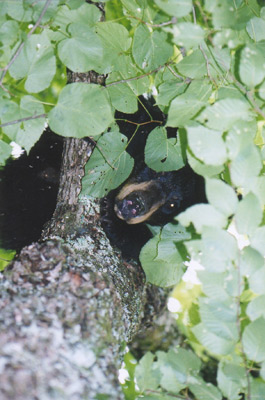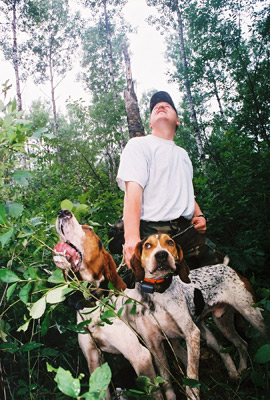THE “BEAR” NECESSITIES… Specialized Training Prepares Warden Recruits
By Dick Ellis
This Column by Dick Ellis was originally published in 2002
Dancing in the mud and water of a distant swamp in the Namekagon Barrens near Minong, Max, Judd, Libby and Josie send their best hound-dog harmony to the skies to announce that the black bear is finally treed. Hundreds of yards to the east, Jason Schroeder stops his beat-up truck one more time on an overgrown dirt road, forces the door open against foliage playing havoc with mirrors and antennas, and strains against the Burnett County winds to get the message.
“I’m not sure what’s going on,” Schroeder says over the radio to a scattered group of fellow houndsmen, a veteran warden from Spooner and a warden recruit from Milwaukee gaining a baptism to the Wisconsin bear hunt with dogs. “But we’re going in to find out.”
I follow Schroeder on the run through a sea of poplar and pine, the growing chorus of baying hounds pulling us down, down, down from the hardwoods to a dark and wet, mossy-bottomed swamp. Into the chaos of a successful hound pack dizzy with celebration. And a boar in the ash above, not nearly so pleased with the chase.
 I lay on my back in the mud shooting up the trunk at the bear, which quickly spins on his perch to hang face down, staring down these new creatures below as obnoxious as the dogs. “Stay up there, bear” Jason shouts standing guard over me, armed with nothing but his voice. “I appreciate that Jason,” I say. “Got to talk to the bears,” he replies, slapping the tree again and repeating his ferocious man-bluff to Yogi.
I lay on my back in the mud shooting up the trunk at the bear, which quickly spins on his perch to hang face down, staring down these new creatures below as obnoxious as the dogs. “Stay up there, bear” Jason shouts standing guard over me, armed with nothing but his voice. “I appreciate that Jason,” I say. “Got to talk to the bears,” he replies, slapping the tree again and repeating his ferocious man-bluff to Yogi.
“This makes mama bear, baby bear, and papa bear, all in one morning,” I think, shooting off more film until Warden Dave Zebro, Warden Recruit Jason Roberts, and bear hunters Jan Luke of Danberry, Dick Johnson of Minong, and Todd Johnson of Shell Lake pour in on the party. “Goldilocks has nothing on these guys.”
Of highest importance, Roberts is seeing it all, through the eyes of a warden, but from the perspective of the hunter as well. The primary purpose of 10-weeks of specialized sessions offering warden recruits scenario-based training dispersed over their first year of hire. Placing recruits in a situational learning mode, specialized training promotes better understanding of hunters, fishermen, and other resource user groups in the soon to be warden.
Curriculum includes hunting accident investigation, boat operation and enforcement techniques, fishing and hunting enforcement techniques, Great Lakes enforcement, waterfowl identification and enforcement techniques, trapping and furbearer management, and snowmobile and ATV operation and enforcement. This late July, early August session included a major dose of fall bear hunting, and an introduction to bear hunting techniques, equipment, and the animal itself.
At Leisure Lake in Washburn County, 12 warden recruits from the class of 2002 heard from a DNR bear biologist, watched the sedation and field work on a captured black bear prior to “nuisance” relocation, and were introduced by hunters to the breeds of bear hounds and varieties of telemetry equipment used in the chase. The following morning, each recruit was placed in the field with a different hunting group for the actual “scenario-based” chases.
Zebro, Roberts and I step into the predawn black of 4:00 a.m. with Schroeder’s hunting partners and headed for the Burnett County wilderness. “This is a morning I would crawl back in bed if not for the warden recruit training,” Schroeder says. “This is as bad as conditions get. High humidity, high winds, and high temperatures It’s hard for the dogs to keep the scent and hard for us to hear the dogs. I don’t think we have a very good chance to tree a bear.”
Schroeder and I slowly drive the sand roads on public land and paper mill property west of Minong using a spotlight to cut the night in search of bear tracks. Our partners work other roads, the radio occasionally cracking with more news of no news at all. In the back of our truck, Schroeder’s three hounds, Max, a treeing walker, Maggie, a Redbone, and Bandit, a Plott, quietly wait their turn.
None of the bait piles placed by the hunters in hopes of starting a track has been hit. In this rugged northwest country, berry crops are extraordinarily good in 2002. Black bears aren’t pressed to seek out artificial handouts when they might instead wallow in a natural blackberry bath.
Eventually, we find three adult sets of bear tracks at a single crossing, unique indeed says Schroeder. A lone wolf track nearby serves as a reminder that the risk is rising for bear hounds in Wisconsin as the territorial packs grow and members listen to their protective instincts to kill dogs. According to DNR Bear Biologist Mike Gappa, 17 bear hounds were confirmed as killed by wolves last season. A number he said, bear hunters will call conservative due to the lack of verification of other kills and losses of dogs not reported by owners.
Gappa also said that approximately 13,500 black bears roam Wisconsin, with 3,000 harvested by hunters annually. It is the hound hunters and bait hunters, he said, who keep the population in check, and restricts the number of resident bear complaint calls from exploding beyond the 922 calls received last year. 322 problem bears were trapped and relocated based on those calls.
 “Hunting is the most valuable tool to any bear management program,” Gappa said. “Were dealing with a long-lived animal that has the ability to add a lot of numbers to the population in a hurry. The states’ experiencing real problems with bears don’t allow hunting. Wisconsin is admired for its bear management program, and it’s because Wisconsin still allows bait hunting, and hunting with dogs.”
“Hunting is the most valuable tool to any bear management program,” Gappa said. “Were dealing with a long-lived animal that has the ability to add a lot of numbers to the population in a hurry. The states’ experiencing real problems with bears don’t allow hunting. Wisconsin is admired for its bear management program, and it’s because Wisconsin still allows bait hunting, and hunting with dogs.”
Night turns to day and the day burns away. Several chases are started on cold tracks with the best cold-tracking dogs owned by the hunters. But they never turn hot. Failure is an easy pill, though, as we travel through the rolling big forest country of Burnett County referred to as Little Montana. The scenery is gentle on the mind.
The trucks converge on the sand roads. Three dogs have been tethered carefully in the open boxes of the trucks for “rigging.” They will open up in song should the scent of bears reach their uncanny sense of smell. Near Little Montana, a chorus of wailing rises to tell the hunters and wardens a bear has crossed the road here.
Actually, one big track and two small tracks upon examination in the sand tell the story of a traveling sow and two cubs. The truck convoy moves on. During the upcoming season a sow with cubs or cubs won’t be legal game anyway. But Schroeder has other reasons for leaving mama alone.
“You rig a track in this bad of scenting conditions, it’s a good track,” Schroeder says. “But I’m not going to throw the dogs on her track and make an unscheduled trip to the vet. She’ll probably put her cubs up a tree, but if she’s the one sow in ten who turns to punch it out, she can be the nastiest critter on earth.”
Nearby, a few dogs are put out onto an old, lone track. We listen as the hounds change in voice tells the story of a cold track turning hot, and eventually, the story of success. We travel the dirt roads as far as we can toward the baying, and then abandon the trucks to run to the dogs. We find the sow intended to be left alone high in a birch, her two cubs higher. The lone bear being trailed had crossed the hotter track of this trio, and the dogs had naturally navigated to the fresher scent.
Warden Dave Zebro has seen treed bears before. As have these hunters from the northwest. But for warden recruit Roberts, and a reporter, it’s cloud-nine time. We let these few minutes sink in, cameras clicking, before the bears are left unmolested again.
Roberts, 25, has hunted and fished all his life, and is becoming a warden to give back something to the resource that has already given him so much. “The best thing about these week-longs (training) is that they’re all scenario-based,” he says. “I have questions, and I need to be with the people who are using the resource to find a lot of the answers.”
“It’s absolutely essential that we give these recruits the hands-on training so that they know how to apply the laws to specific situations,” says Zebro, a veteran Field Training Officer (FTO) who works closely with a recruit over much of his first year. “When a recruit works with the hunters, they see the situation through the hunter’s eyes as well as through the eyes of law enforcement. That allows the recruit to better evaluate a situation before making a decision.”
We pull the dogs away, and are amazed at the speed in which the bears descend the birch when offered the smallest window of opportunity. In literally seconds, mama and babies have dropped the 50 to 60 feet and are off and rambling again.
With almost eight hours in the field, the dogs find our “bonus” bear. Schroeder and I find the boar down in the swamp, up in the ash. One hound, Libby is wearing a small, red badge of courage, courtesy of one swipe of bear claw to the face. A blunt boar message letting dog know what he thinks of this nonsense before taking to the tree.
We leave the bear alone again following a ten minute photo shoot. Jason Roberts, warden recruit from Milwaukee, is wearing the look of a more street-wise, a more woods-wise law enforcement officer.
“It’s so important to work with these bear hunters,” says Zebro. “Of all the user-groups, hunters with dogs are the most criticized, least understood group. From the outside it looks easy. But when you get in the trucks, you know how difficult it is. If we’re going to work with them, we have to understand them. You can’t place enough emphasis on that kind of training. You can do classroom work every day from dawn to dusk, and never give these recruits the same benefit.”







